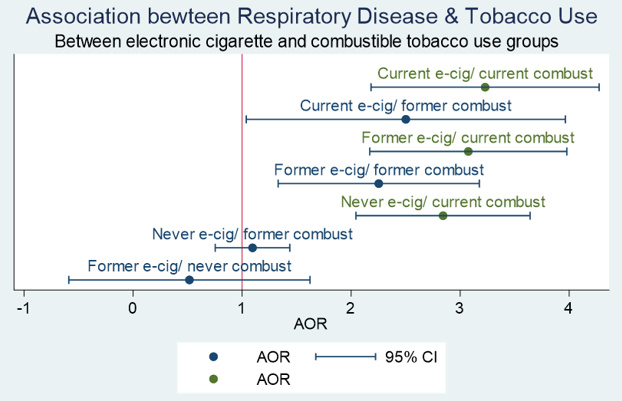In the US and many other countries, smoking is the leading preventable cause of death. Tobacco control policies discourage teens from starting to smoke and encourage adult smokers to quit. Instead of policies focused on abstinence from tobacco, the development of modern electronic cigarettes has renewed interest in products that reduce the harm from tobacco use. Harm reduction, such as needle exchange programmes to reduce diseases among intravenous drug users, is an established public health approach. But tobacco harm reduction has been controversial.
The consensus report by the National Academy of Sciences, Engineering, and Medicine concluded that “[t]here is conclusive evidence that completely substituting e-cigarettes for combustible tobacco cigarettes reduces users’ exposure to numerous toxicants and carcinogens present in combustible tobacco cigarettes” (National Academies 2018). However, the American Lung Association’s (2015) and other groups’ policy statements on e-cigarettes have emphasised the uncertainty about the long-term health consequences of e-cigarette use.
Obviously, the harm-reduction potential of e-cigarettes for adult smokers depends on whether use actually reduces harm. Moreover, the popularity of e-cigarettes among teens makes the possible long-term health consequences especially alarming. Among US adults, e-cigarettes are most popular among current and recent former smokers (Villarroel et al. 2020). However, among teens, vaping e-cigarettes is now more common than smoking, and the rapid increase has been termed an ‘epidemic’ (FDA 2020). In the National Youth Tobacco Survey, the fraction of high school students reporting e-cigarette use within the past 30 days increased from 11.7% in 2017 to 27.5% in 2019 (Cullen et al. 2018, Wang et al. 2019).
In a recent study, Bhatta and Glantz (2019) investigate whether e-cigarette use is associated with long-term respiratory disease.1 They analysed observational data from the first three waves of the Population Assessment of Tobacco and Health (PATH) study, a large longitudinal dataset sponsored by the US Food and Drug Administration. Based on statistically significant longitudinal associations between former and current e-cigarette use and subsequent respiratory disease, Bhatta and Glantz conclude that “[u]se of e-cigarettes is an independent risk factor for respiratory disease in addition to combustible tobacco smoking.”
Major news media reported the results of Bhatta and Glantz’s study, including NBC (2019), Reuters (2019), and National Public Radio (NPR 2019). NPR, for example, reported that the study “found that people who used only e-cigarettes had about a 30% increased risk of developing lung disease, compared with people who didn't use any nicotine products” (emphasis in the original). The accompanying press release (Alvarez 2019) and news media reports interpreted the estimated associations as showing that e-cigarettes are “harmful on their own” (Glantz, quoted in Alvarez 2019).
As economists, we understand how difficult it is to empirically establish causal relationships between product use and health outcomes. Unlike FDA decisions about prescription drugs, FDA decisions about tobacco regulations cannot rely on evidence from randomised clinical trials. The ethical treatment of human subjects prohibits researchers from randomly assigning some people to smoke combustible tobacco and others to vape e-cigarettes. Instead, when regulating tobacco FDA often relies on evidence from the analysis of observational data, like the PATH data used by Bhatta and Glantz. Because it addressed difficult empirical questions with important policy implications, we took special interest in Bhatta and Glantz’s study (Kenkel et al. 2020).
Our examination of the statistical model used by Bhatta and Glantz suggested to us that a more flexible specification was needed to isolate the independent effect of e-cigarette use on respiratory disease. Although Bhatta and Glantz statistically controlled for smoking status when they estimated the association between e-cigarette use and respiratory disease, their model assumed that the association was the same for never smokers, former smokers, and current smokers. To isolate the effect of vaping, we extended the analysis by adopting a more flexible empirical specification. Our regression specification uses a set of eight indicator variables (and a reference category) based on the exhaustive set of nine possible combinations (a 3 by 3 design with never, current, or former smoker of combustible tobacco being interacted with never, current, or former user of e-cigarettes). Our more flexible specification revealed important insights.
First, among respondents who had never smoked combustible tobacco, we find no evidence that current or former e-cigarette use is associated with respiratory disease. The statistical associations that Bhatta and Glantz find between e-cigarette use and respiratory disease are driven by e-cigarette users who are also current or former smokers of combustible tobacco. A striking feature of the PATH data analysed by Bhatta and Glantz is that almost all e-cigarette users were either current or former smokers of combustible tobacco. In the longitudinal analysis sample with 17,601 observations, there were only 12 current e-cigarette users who had never smoked combustible tobacco. None of these 12 respondents had incident (new) respiratory disease.
Second, because almost every e-cigarette user was either a smoker or former smoker, we also compared the outcomes of smokers to the outcomes of dual users. Bhatta and Glantz interpret their results as showing increased risk from dual use; in the press release Glantz is quoted as stating that dual users “are actually worse off than tobacco smokers” (Alvarez 2019). In contrast, we find that the sole use of combustible tobacco and dual use with e-cigarettes have essentially the same statistical relationship with the onset of respiratory disease. The estimated regression coefficients and odds ratios are quite similar, and in some cases almost identical. Most importantly, in all cases the confidence intervals around the estimates very much overlap with each other. Our estimates imply that compared to non-smokers, dual users are more likely to develop respiratory disease. But we do not find any practically important differences between smokers and dual users.
Figure 1 Association between respiratory disease and tobacco use
Note: Reference group is never e-cig/never combust. The logistic model does not provide an estimate of the AOR for the category current e-cig/never combust because none of the respondents in this category had an incident respiratory condition.
Source: PATH study public-use files for adults from waves 1 to 3.
We believe that future work that uses the approach and methods of applied econometrics can shed more light on the long-term health consequences of e-cigarette use. The study by Bhatta and Glantz and our extension are examples of risk-factor epidemiology and only estimate statistical associations. A key challenge for future research is that in observational data, people are not randomly assigned into e-cigarette use; instead, they self-select into e-cigarette use. The high levels of e-cigarette use among adult former smokers suggest that many adults self-select into e-cigarette use as a way to stop smoking combustible tobacco. Because health concerns often drive smoking cessation, this creates potential reverse causality if health problems cause people to select into e-cigarette use.
Applied econometrics provides a systematic framework for future research on the causal health effects of e-cigarette use. A productive line of applied econometrics emphasises the importance of finding quasi-experimental variation that credibly identifies the causal effect of an independent or treatment variable on the outcome of interest. Possible examples include plausibly exogeneous supply-side shocks or public policies that increase the cost of obtaining e-cigarettes. The resulting variation in e-cigarette use provides a quasi-experiment where some people are more-or-less randomly assigned (by the exogenous shifters) to different levels of e-cigarette use. Quasi-experimental methods in econometrics to identify causal effects include event studies, differences-in-differences, instrumental variables, and the regression discontinuity design (Angrist and Pischke 2009).
Decades ago, in his proposal for safer cigarettes, Russell (1976) observed that “[p]eople smoke for the nicotine but die from the tar”. Tar is the by-product of combustion, so Russell’s observation explains the harm-reduction potential of non-combusted tobacco products including smokeless tobacco, ‘heat not burn’ products, and e-cigarettes. After reviewing scientific evidence submitted by the manufacturers, in 2019 and 2020 the FDA authorised snus smokeless tobacco products and a ‘heat not burn’ product through the modified-risk tobacco product pathway. Swedish Match is allowed to market its snus products with the claim that “[u]sing General Snus instead of cigarettes puts you at a lower risk of mouth cancer, heart disease, lung cancer, stroke, emphysema, and chronic bronchitis”. Philip Morris is allowed to market its heat-not-burn product with the claim that “[s]cientific studies have shown that switching completely from conventional cigarettes to the IQOS system significantly reduces your body’s exposure to harmful or potentially harmful chemicals”.
E-cigarettes are much more popular in the US than snus or ‘heat not burn’ products and appear to offer at least as much harm reduction potential for smokers. Further research is needed to explore the tradeoffs between harm reduction for current adult smokers versus potential harms to new teen vapers.
References
Alvarez, J (2019), “E-Cigarettes Significantly Raise Risk of Chronic Lung Disease, First Long-Term Study Finds”, University of California, San Francisco.
American Lung Association (2015), “American Lung Association statement on e-cigarettes”.
Angrist, J D and J-S Pischke (2009), Mostly Harmless Econometrics: An Empiricist’s Companion, Princeton University Press.
Bhatta, D N and S A Glantz (2019), “Association of E-Cigarette Use with Respiratory Disease Among Adults: A Longitudinal Analysis”, American Journal of Preventive Medicine 58(2): 182-190.
Cullen, K A, B K Ambrose, A S Gentzke, B J Apelberg, A Jamal, and B A King (2018), “Notes from the Field: Use of Electronic Cigarettes and Any Tobacco Product Among Middle and High School Students—United States, 2011-2018”, Morbidity and Mortality Weekly Report 67(45): 1276-7.
FDA – Food and Drug Administration (2020), “FDA Finalizes Enforcement Policy on Unauthorized Flavored Cartridge-Based E-Cigarettes That Appeal to Children, Including Fruit and Mint”.
Kenkel, D S, A D Mathios, and H Wang (2020), “E-Cigarettes and Respiratory Disease: A Replication, Extension, and Future Directions”, NBER Working Paper 27507.
National Academies (2018), Public Health Consequences of E-Cigarettes, The National Academies Press.
NBC (2019), “E-cigarettes Linked to Lung Problems, First Long-term Study on Vaping Finds”.
NPR (2019), “Vaping Nicotine Linked to Increased Risk of Chronic Lung Disease”.
Reuters (2019), “Vaping Increases the Risk of Lung Disease by a Third: U.S. Study Finds”.
Russell, M A H (1976). “Low-tar medium-nicotine cigarettes: A new approach to safer smoking”, British Medical Journal 1: 1430–1433.
Villarroel M A, A E Cha and A Vahratian (2020), “Electronic cigarette use among U.S. adults, 2018”, National Center for Health Statistics Data Brief No. 365.
Wang T W, A S Gentzke, M R Creamer et al. (2019), “Tobacco Product Use and Associated Factors Among Middle and High School Students —United States, 2019”, MMWR Surveill Summ 68(SS-12):1–22.
Endnotes
1 Shortly before the publication of Bhatta and Glantz’s study, in the late summer and autumn of 2019 the US experienced an outbreak of acute lung injury that the CDC termed ‘e-cigarette, or vaping, associated lung injury’ (EVALI). As of the final CDC reporting date (18 February 2020), there were a total of 2,807 hospitalised EVALI cases or deaths reported nationwide, including 68 deaths (CDC 2020). The CDC eventually linked the EVALI outbreak to illegally manufactured e-cigarettes that contain THC (the psychoactive component of marijuana) and vitamin E acetate; EVALI was not found to be linked to commercially available e-cigarettes that contain nicotine. Bhatta and Glantz examine the association between nicotine-containing e-cigarettes and long-term respiratory diseases such as chronic obstructive pulmonary disease (COPD); they do not study EVALI.







